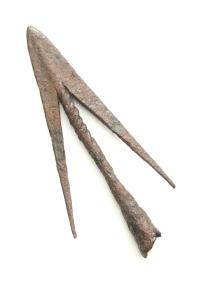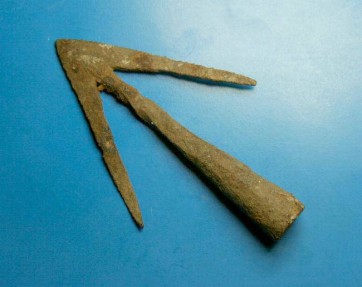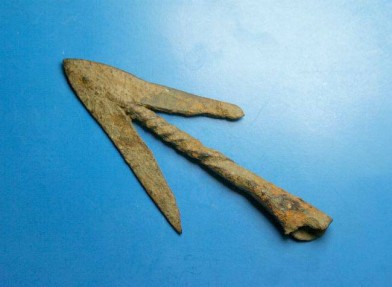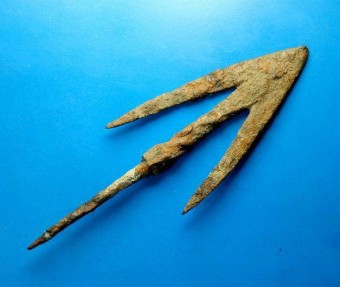
 |
|
|
|
|
#1 |
|
(deceased)
Join Date: Sep 2008
Location: Bavaria, Germany - the center of 15th and 16th century gunmaking
Posts: 4,310
|
This is a follower to post #31-32 and #62, showing more on digging up those grenades from a historic site in May 1983.
Best, Michael |
|
|

|
|
|
#2 |
|
(deceased)
Join Date: Sep 2008
Location: Bavaria, Germany - the center of 15th and 16th century gunmaking
Posts: 4,310
|
A few more, and a local neswpaper article of May 11, 1983.
m |
|
|

|
|
|
#3 |
|
(deceased)
Join Date: Sep 2008
Location: Bavaria, Germany - the center of 15th and 16th century gunmaking
Posts: 4,310
|
Some 16th c. sources of period artwork on grenades, from top:
- Vannoccio Biringuccio (+1537), De la Pirotechnica, 1534-5, printed posthumously - Romeyn de Hooghe (+1708), Austrian grenadiers at the Turkish Siege of Vienna, 1683: the Austrian grenadiers are depicted throwing their grenades high above the heads of the defenders against the Turks, thus taking into account losses on their own side - as before and some clay and glass grenades from the vast supplies preserved at Schloss Forchtenstein, Austria. All scanned from: Franz Felberbauer, "Die Handgranaten der Grenadiere der Fürsten Esterházy aus Gusseisen und Ton im Zeughaus der Burg Forchtenstein" (the cast-iron and clay hand grenades for the grenadiers of the Princes Esterházy, at the Armory of Forchtenstein Castle), in: Waffen und Kostümkunde, 2012, vol. 2, pp. 181-220, and 2014, vol. 1, pp. 1-52. m Last edited by Matchlock; 18th March 2014 at 02:35 PM. |
|
|

|
|
|
#4 |
|
(deceased)
Join Date: Sep 2008
Location: Bavaria, Germany - the center of 15th and 16th century gunmaking
Posts: 4,310
|
Before Felberbauer's comprehensive and topical study on the 17th c. Schloss Forchtenstein hand grenades, published in two vols. of the German Journal of Weaponry (Zeitschrift für historische Waffen- und Kostümkunde) in 2012 and 2014 (see post above), there have sadly only been two tentative aprroaches to the matter, both made by Heinz-Peter Mielke in the same Zeitschrift, in 1980 (vol. 2, pp. 153f.) and 1982 (vol. 1, pp.64-66).
For those to whom German is not just an accumulation of hieroglyphs    , I attached scans. , I attached scans.The first essay is on 17th-18th c. glass hand grenades in the Swiss Landesmuseum Zurich, while the second is on clay hand grenades in general (Mielke called them ceramic weapons). Best, Michael |
|
|

|
|
|
#5 |
|
Member
Join Date: Jun 2013
Location: Netherlands
Posts: 535
|
I found this link to a manuscript about munitions and explosive devices ( Ms. Codex 109 - Helm, Franz, approximately 1500-1567 - Feuer Buech )
Maybe it has been published before but i find it rather interesting. In the top left corner you can leaf trough the illustrattions with eas, or on the right upper corner you can browse trough every page (my post medieval German is not what it used to be so i skipped to the images  ) )Also some other manuscripts i think on the same site. http://dla.library.upenn.edu/dla/med...urrentpage=392 |
|
|

|
|
|
#6 |
|
(deceased)
Join Date: Sep 2008
Location: Bavaria, Germany - the center of 15th and 16th century gunmaking
Posts: 4,310
|
Hi Marcus,
This the so-called Buch von den probierten Künsten (on well-tried arts), printed in 1535. I attached some samples which are of interest in our thread although Helm's original intention was to demonstrate fireworks as a means of merrymaking. The bottom attachments depicts a notable device quite similar to some presented by Franz Helm; Veste Coburg collections; and two glass hand grenades for the so-called Greek Fire, 10th-12th c., and a few caltrops; National Historic Museum Athens. Best, Michael Last edited by Matchlock; 18th March 2014 at 11:35 PM. |
|
|

|
|
|
#7 |
|
(deceased)
Join Date: Sep 2008
Location: Bavaria, Germany - the center of 15th and 16th century gunmaking
Posts: 4,310
|
And finally I found this in my archives:
a roll of 17th/18th century matchcord for kindling hand grenades! The grenadier just had to take out the wooden plug, pull a small length of match off that quill, light it and set fire to the fuse of the grenade. After throwing the grenade he would just push the match right back into its wooden case and replug it, and the glow would die for lack of oxygen. Now ain't that a perfect device? Photographs: Armin König, Germanic National Museum (GNM) Nuremberg. Best, Michael |
|
|

|
|
|
#8 |
|
Member
Join Date: Jun 2013
Posts: 8
|
Hi Matchlock
I wanted to run this article by you, regarding those twisted socket arrowheads: http://www.tameshigiri.ca/2014/03/14...isted-sockets/ I've come across these examples of twisted arrowheads. My organization is considering getting one of these for our traveling display of medieval antiquities, which is why I've been so curious about them. 102 mm long:  75mm long:  80mm long:  88mm long: 
|
|
|

|
|
|
#9 |
|
(deceased)
Join Date: Sep 2008
Location: Bavaria, Germany - the center of 15th and 16th century gunmaking
Posts: 4,310
|
Hi Eric,
You can of course never tell for sure when confronted with Medieval relics but in my opinion, and in all probability, these arrow shaped heads with the twisted hafts were used together with an incendiary mass. The latter would probably stick more safely on a twisted haft. Illustrated at the right-hand side of the attached photos is a crossbow bolt with its incendiary mass now missing. Best, Michael Last edited by Matchlock; 15th April 2014 at 06:19 PM. |
|
|

|
 |
| Thread Tools | Search this Thread |
| Display Modes | |
|
|